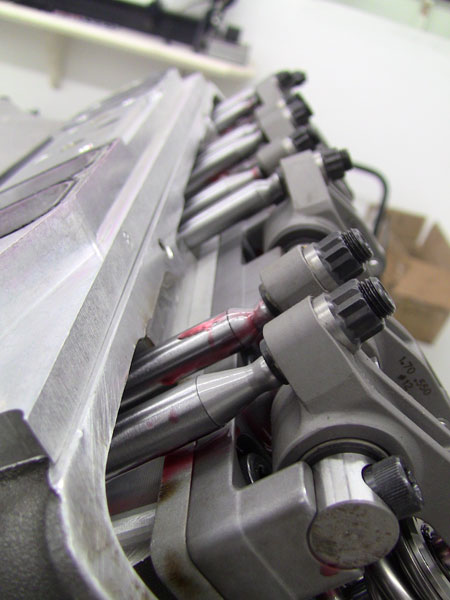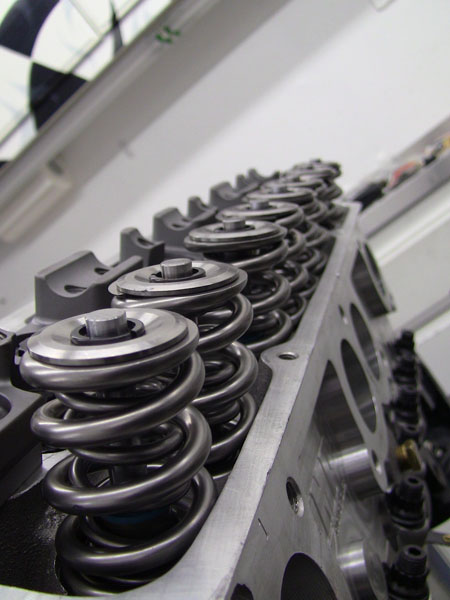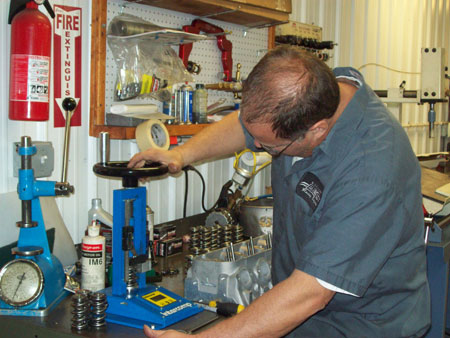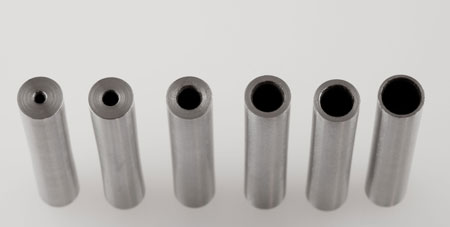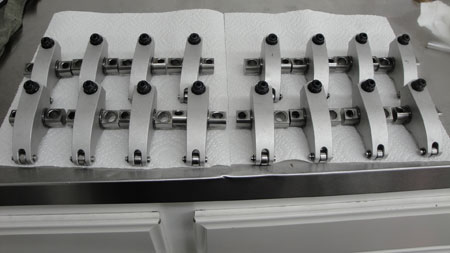Selecting the right components to make a rock-solid valvetrain is key to assembling an engine that will last – and win. The pushrods, rockers and valve springs must be able to handle all of the stresses of the camshaft rotating with high spring pressures and with huge lift. Weakness in any part of the system will be a disaster.
The industry’s top suppliers of these components have tested and refined their products to ensure that your design requirements will be met and exceeded. Thanks to their commitment to research and development, your efforts can be put toward selecting the proper combination of parts, confident that they’ll contribute strength and power to your engine build.
Comp Cams
One of the key questions regarding valvetrain design concerns mass, according to Comp Cams’ Billy Godbold. Does reducing mass reduce the overall system stiffness, and by how much? Will reducing the mass result is high stress that could result in failure? Will reducing the component mass significantly change the effective system mass?
“With these three questions in mind, we try to reduce the mass as much as possible, while retaining as much system stiffness as possible AND closely watching for highly localized stress concentrations through both finite element analysis (FEA) and endurance testing on our Spintron test cells,” he says.
Godbold recommends check system stiffness by measuring static max lift with a flow bench checking spring versus the running spring with everything else constant. The system stiffness is the difference in load divided by the difference in lift. “The best systems,” he says, “have BOTH high stiffness and low effective mass.”
Valve spring materials are something of their own animal, Goldbold suggests, and they’re not what they used to be. “The high grades of super clean chrome silicon wire we use today are far better than even the best wire we had in NASCAR a decade earlier,” he explains. “And these are quite difficult to compare to even the best aerospace steels available today. For steel rocker arms we use 8620 on the roller tip rockers and 8650 on the full roller Ultra Pro Magnum and XD rockers. Our Ultra Gold rockers use a specifically selected aluminum alloy for the unique stress and temperature requirements of rocker arms.”
The key to selecting the right component, according to Godbold, is to have a good relationship with a manufacturer you trust.
“There are so many nuances to the designs and materials of today’s valvetrain components that you could have both an advanced engineering and metallurgy degrees and still fall into traps unique to the valvetrain world. For example, most 5/16” standard wall pushrods commonly see loads above the buckling load. The only reason they lift is that the load durations are so short that the part never has time to fail before the load spike relaxes.”
Godbold suggests one of two methods to valve spring selection: either to stay with a combination that is known to work well through experience, or invest the time needed to run both dynamics and durability testing.
“We use a Spintron test fixture,” Godbold says. “A typical test would be approximately 2-3 days of dynamics followed by 3-5 days of durability, depending on the type of racing, and Spintron testing runs approximately half again to twice as much per day as professional dyna-mometer testing.”
Crane Cams
The balance between reliability and cost-effectiveness must always be part of the parts choice equation, according to Crane Cams’ Chase Knight.
“Some folks have unrealistic expectations regarding performance and reliability. It all comes down to the compromises that need to made for time/quality vs. dollars,” Knight explains. “It’s best to plan out your entire combination first (including the vehicle it’s going into), before a single part is purchased, so you only need to do it once. There is no magic camshaft that will cure a mismatch of poorly chosen items.”
Knight concurs that valve springs should be tested on a quality tester, that has been verified with a special checking spring. The inner springs (and dampers, if equipped) should be preloaded with the proper step thickness as provided by the specified retainer.
“Run the valve spring down to coil bind a few times, then check the pressures at the various checking heights when returning from the coil bind position. This will ensure that any hysteresis in the wires is considered in the load readings,” he says.
The valve spring industry has a general tolerance of plus or minus ten percent on all but the most expensive springs, so be aware of variations, if your supplier does not individually match their sets.
Edelbrock
Edelbrock’s Smitty Smith says his company regularly develops new valvetrain components. “We now offer aluminum roller rockers for our crate engine program which is also used with our top end kits and add-on sales when retailers sell our accompanying engine products,” he says. “We also offer matching pushrods and valve springs for all of the engines we offer hydraulic flat tappet and hydraulic roller camshafts for. Eliminating the guess work as we make sure that they all work together. This is part of our total power package.”
Smith says the most important factor for choosing the correct springs is to use the ones recommended by your camshaft supplier. “Basically, there are different valve springs for the different type of camshafts, hydraulic flat tappet, hydraulic roller, solid roller,” he notes.
When an engine builder switches from a stud mounted rocker to a shaft mounted rocker, Smith says that this is most common in racing applications where they use hydraulic roller and solid roller camshafts with aggressive valve spring pressures. He says it ensures a very stable valvetrain at all rpm’s.
Elgin
“Everyone is always conscious of keeping the reciprocating mass (weight) down as a total,” says Elgin’s Dan Gathman. “That includes the weight of the lifter, pushrod, valve, valve spring, rocker, retainer, all the way through that circuit.”
From a performance standpoint, Gathman says, the weight on the valve side of the rocker is the most critical to control. “That mass is what provides the impact load on the seats of the valves. The mass increases the inertia that you have to overcome to reverse the direction of the valve, the higher the rpm the more important minimizing this force becomes.
Gathman says that Elgin has developed and is testing a new heavy-wall, fully machined one-piece chrome moly pushrod. “Right now the offering we have is a straight wall pushrod,” he says, “but that wall is thick enough to support a fully hard- turned configuration. The final machining process is done after the heat treating so we can get an exact radius and very good surface finish.” And it’s DEAD ON accurate, according to the folks at Elgin.
“On the pushrod side of the rocker, weight is not typically a big concern for racing and performance guys,” says Gathman. “They are looking for stiffness. So whatever the cam profile is, they want the valve to follow that as close as possible. That’s one of the reasons that the high performance industry wants the biggest, fattest, strongest pushrod that you can possibly fit in the engine, even at the expense of adding more mass to the engine.”
Elgin president Bill Skok says, “What we’ve seen with our different materials such as stainless steel rockers that we have and even our cryogenic valvetrain components have been taking off.” He says the Black Ice product line (rockers) is getting longer and better wear. And the parts are stronger through their treatment process.
“What we have is different than what is typically out in the field. We have the ability to perform a super cryogenic treatment,” says Elgin’s Rick Simko. “Out in the field a cryogenic treatment will typically be around -120 degrees F below zero. With our super cryogenic treatment it is between -250 F and -300 degrees F below zero. So we do a super cryo but the metallurgical advantages and benefits are still not fully understood. It’s very difficult to get quantifiable data to show the amount of the improvement but there is an improvement. The performance in the field suggests that the improvement goes in the right direction. In most cases it adds durability and in some cases it adds strength.
K-Motion
When it comes to valvetrain components, K-Motion’s Bob Kamp says weight is important. “Anything that changes directions needs to be light,” he says, noting that they have recently added a number of new springs to their catalog. “We have 19 part numbers that cover 95% of the market. Our springs are made of a new high tensile steel.”
Kamp recommends using a bench tester to check all springs and then to start the engine and bring it up to temperature. “Use an engine tester (LSM) to check again,” he says. “This will give you a good baseline on a new spring.”
Manton Pushrods
“Some of our newest valvetrain ideas are a .281? ball adjuster, which is used to replace the standard cup adjuster,” says Manton Pushrods’ Alan Perkins. “The pushrod end used with the .281 ball adjuster is produced from H-13 tool steel and is fitted with a copper alloy insert.”
Perkins says the pushrod ball adjusters are available in 7/16? x 20? and 3/8? x 24? sizes, with or without pressure feed oiling. They also make custom sizes upon request.
Perkins says Manton prefers to use 4130 chrome moly seamless material for its pushrod tubes, as well as S-7 tool steel along with their own heat treating methods. “We use 86L20 standard bearing material and H-13 tool steel for our tip ends,” he says. “These materials are needed to ensure proper function with all rocker arm adjusters.”
PRW
The weight of rockers can vary based upon material content and types of lifter being utilized. Chris Roberts from PRW Industries explains that a variety of materials is used to offer an assortment of products.
“We use a variety of materials in the construction of our rocker from our investment cast 4340 Steel Sportsman Series (for flat tappet cams), 15-5 Pro Series and 17-4pH Alloy Steel Platinum Series, and top of the line Performance Quotient (PQx) aluminum shaft mounted rocker arm systems. Each has a specific benefit depending on the type of engine being built, weather that is a small high rpm motor or large torque-churning build,” says?Roberts.
“One of the newest products that we have developed is the GM LS3/L92 Platinum Series rocker with 1.7 Ratio offset intake rockers. This system integrates a 0.675? complement bearings, 0.875? micro polished trunnions, alloy steel full roller body and an internal oiling system to insure proper lubrication at all engine speeds and horsepower levels. A Clear Nitron finish adds to their strength and reliability for years of worry free operation,” explains Roberts.
Trend Performance
The largest percentage of Trend pushrods is made from chrome molybdenum, a type of alloy steel known as 4130. “This material,” says Trend’s Andy Anderson, “possesses an excellent strength-to-weight ratio and is considerably stronger and harder than standard 1020 steel. Sprint Cup engines use it as do much of Pro Stock and Pro Mod. In contrast, Top Fuel and Funny Car teams use H13 tool steel in solid bar form.”
The 4130 pushrods are produced from thick-wall tubing. Their hollow center passage is pressurized by oil destined to lubricate the rocker adjuster.
For competition engines operating under extreme pressures such as Mountain motors, Pro Mod, Pro Nitrous, Top Sportsman, NHRA Pro Stock and fast Bracket engines, Anderson says Trend has introduced a new series of 5/8? pushrods. “Created from 4130 chrome molybdenum thick-wall tubes, they are constructed as one-piece units and available with wall thicknesses of 0.188? or 0.125? and in lengths ranging from 8? to 13.500? long,” he says. “They are also supplied with a plain radius cup or with a BZ radius cup.”
Anderson says these are high load-bearing bronze inserts that overcome galling troubles that occur between the rocker ball and the pushrod’s upper cup. “Galling is an ominous condition perpetuated by the use of extremely lightweight lubricating oils,” he says “Moreover, Trend is also making the balls and cups available in our latest self-lubricating tool steel.”
Trick Flow
Trick Flow has expanded its offering of valve springs to cover more applications and uses American-made springs from PAC Racing Springs. PAC Racing Springs is the performance division of Peterson Spring. They have been making springs for nearly 100 years.
“The valve springs are batch fatigue tested before shipment to ensure they meet Trick Flow’s stringent durability requirements,” explains Mike Downs of Trick Flow. “We list recommended components (retainers and locks) to match the springs to help take some of the work out of finding the right components. We also list recommended applications for each spring.”
Trick Flow offers US-manufactured chromoly pushrods in 5/16” and 3/8” diameters. The pushrods are available in many lengths from 6.250” to 9.000” (5/16”) or 7.650” to 9.950” (3/8”).
“Our US-made aluminum roller rockers feature heat-treated CNC-machined bodies, premium needle bearing fulcrums, roller tips, and a machined relief for improved valve spring clearance,” says Downs. “They are well-matched to Trick Flow cylinder heads, and can be used on most factory and other aftermarket heads, too.”
For contact information on these and other suppliers of valvetrain components, visit our exclusive online Buyers Guides.
